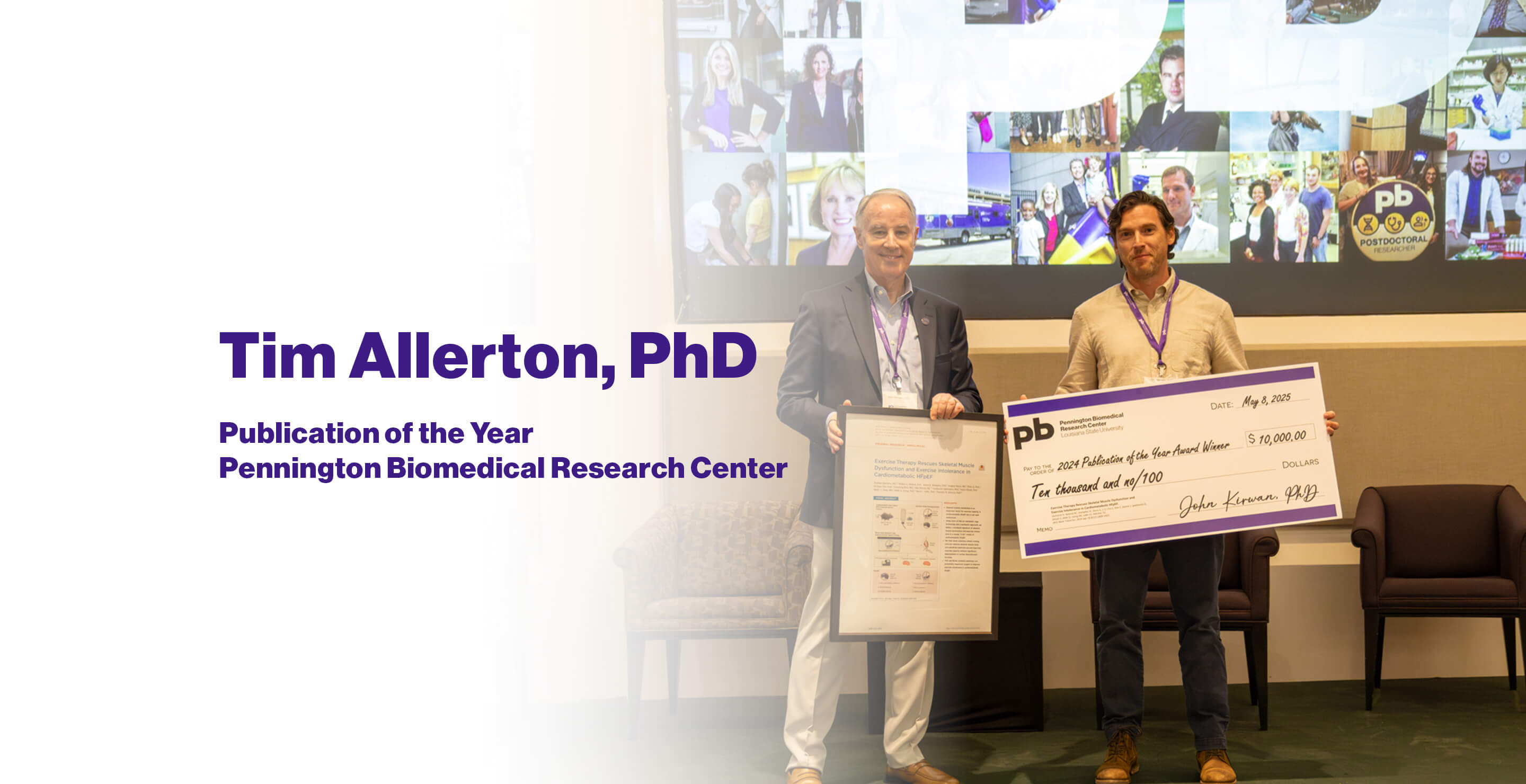Pennington Biomedical Q&A: Dr. Timothy Allerton
June 2, 2025 · Baton Rouge, LA
Dr. Timothy Allerton’s research on a growing cardiovascular condition was named Publication of the Year at Pennington Biomedical Research Center
Timothy Allerton, PhD, is an assistant professor of vascular metabolism at Pennington
Biomedical Research Center. He is a licensed clinical exercise physiologist. During
his postdoctoral fellowship, also at Pennington Biomedical, Dr. Allerton developed
a strong interest in the link between vascular function and metabolism. In May, several
research data posters, presentations, and publications were evaluated by Pennington
Biomedical faculty, with Dr. Allerton’s publication “Exercise Therapy Rescues Skeletal
Muscle Dysfunction and Exercise Intolerance in Cardiometabolic HFpEF” selected as
the Publication of the Year among those produced by peers and colleagues.
Dr. Allerton recently participated in a Pennington Biomedical Q&A, explaining the
motivations behind his research, the importance of his lab’s ongoing efforts, and
his advice for up-and-coming researchers.
Q: What first sparked your interest in studying exercise therapy and cardiometabolic
disease? Why cardiometabolic HFpEF in particular?
A: Early in my career, I worked as a clinical exercise physiologist treating patients
with cardiovascular disease. This experience gave me a deep appreciation for the importance
of cardiovascular and respiratory fitness, and of exercise to improve outcomes for individuals with heart failure. In
recent years, the obesity epidemic has dramatically altered how heart failure can
affect your health, including the growing prevalence of heart failure with preserved
ejection fraction, or HFpEF. In HFpEF, the heart struggles to relax properly between
beats, and what makes this condition unique is that nearly every organ system—including
skeletal muscle, kidneys, and liver—is both affected by and contributes to the disease
process. It has now become the most common form of heart failure in the United States.
Patients with HFpEF suffer from significantly reduced quality of life, frequent hospitalizations,
and, most alarmingly, nearly 50 percent die within five years of diagnosis. The hallmark
symptom is exercise intolerance, characterized by severe shortness of breath and fatigue
during routine daily activities such as housework or grocery shopping. Emerging research
suggests that skeletal muscle dysfunction may account for more than 50 percent of
this exercise intolerance – a major paradigm shift from the traditional view that
cardiac dysfunction is solely responsible. My research on skeletal muscle and vascular
metabolism positioned my lab to uncover the root causes driving exercise intolerance
in HFpEF.
Q: For those outside the medical world, can you give a simple explanation of what
your study found?
A: While we know that regular exercise helps patients with HFpEF feel better and move
more easily, we haven’t fully understood why it works.
The main takeaway is that, in people with HFpEF, the major reason for fatigue and
exercise intolerance may not be the heart, but rather poor energy use in the muscles.
And importantly, exercise can address this issue by improving muscle metabolism. These
findings could help shape new treatments that target the muscles and metabolism –
not just the heart – to help people with HFpEF feel better and live longer.
Q: Are you continuing this line of research or branching into something new?
A: HFpEF is widely regarded as the greatest unmet need in cardiovascular medicine.
As such, our lab remains committed to addressing this critical challenge through two
main areas of focus: first, uncovering the fundamental mechanisms underlying the development
of HFpEF, and second, advancing novel therapeutic strategies to treat exercise intolerance.
HFpEF is a serious and growing health concern, with diagnoses rising steadily. Yet,
no specific treatment has been approved, and no clinical trial to date has demonstrated
a reduction in overall mortality. We believe this represents a unique opportunity
for our team at Pennington Biomedical to make a meaningful and lasting impact – both
in the field of cardiometabolic research and in the lives of patients affected by
this debilitating condition. For more information contact: Joe Coussan, Media Relations Manager, joe.coussan@pbrc.edu, 225-763-3049 or Ernie Ballard, Senior Director of Communications & Marketing, ernie.ballard@pbrc.edu, 225-263-2677. About the Pennington Biomedical Research Center The Pennington Biomedical Research Center is at the forefront of medical discovery
as it relates to understanding the triggers of obesity, diabetes, cardiovascular disease,
cancer and dementia. Pennington Biomedical has the vision to lead the world in promoting
nutrition and metabolic health and eliminating metabolic disease through scientific
discoveries that create solutions from cells to society. The center conducts basic,
clinical, and population research, and is a campus in the LSU System. The research enterprise at Pennington Biomedical includes over 600 employees within
a network of 44 clinics and research laboratories, and 16 highly specialized core
service facilities. Its scientists and physician/scientists are supported by research
trainees, lab technicians, nurses, dietitians, and other support personnel. Pennington
Biomedical is a globally recognized state-of-the-art research institution in Baton
Rouge, Louisiana. For more information, see www.pbrc.edu.
Pennington Biomedical Research Center
Q: What advice would you give to early-career researchers who want to make an impact
with their work?
A: So much of your career will be shaped by how you respond to the most pressing challenges
of our time. The greatest advances often arise when people with unique skills, backgrounds,
and perspectives bring their creativity to address the biggest, most complex problems.
Whether it’s heart failure, Alzheimer’s disease, or cancer – find the spaces where
the need is greatest, where the questions remain unanswered, and where the stakes are high.
6400 Perkins Road
Baton Rouge, LA 70808



